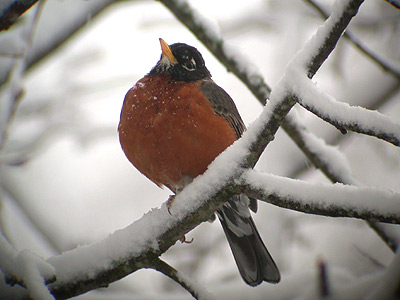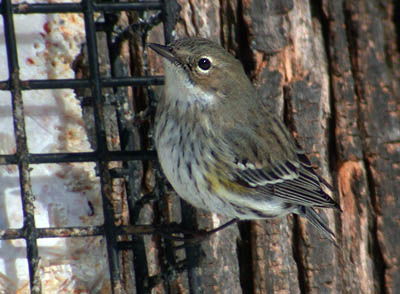
So far we have over an inch or two of fresh snow on the ground, which brought a flock of around 150 blackbirds (grackles, redwings and cowbirds) to our backyard this morning and they quickly devoured the birdseed. Even American Robins were consuming safflower while others foraged along the driveway and curb hoping to find something to eat. This particular robin (above photograph) seemed a just little disgusted by the whole wintery, white mess this spring snowstorm has brought to southern Wisconsin. The forecast says to expect as much as 7 inches of snow, but the temperatures are going to be above freezing during the day and will climb to the 40’s and 50’s again by Monday.
Extremely cold weather kills recently hatched insects that some birds eat, but many of the bird species that have migrated to Wisconsin thus far are generalists and can eat other food items such as nuts, fruit, berries and seeds. My colleague Kristen told me she had a pair of Yellow-rumped Warblers eating fruit suet in her backyard a few days ago, but the key for their survival is finding such available foods. Some Yellow-rumped Warblers have been known to endure temperatures down to 20 below provided there is a source of food to keep them going.

Yesterday I observed over 25 Yellow-rumped Warblers at Pheasant Branch. The temperatures were back in the upper 40’s, bringing the return of flying insects and the warblers were busily feasting on them. But a few days ago when it was below freezing, I watched mixed flocks of Golden-crowned Kinglets and Yellow-rumped Warblers working along the stream corridor. It seemed they were particularly interested in whatever was in the damp soil just above the stream's waterline. I can't tell what exactly they were eating, but they were definitely finding abundant food items. I also observed Yellow-rumped Warblers taking on a more scavenging strategy as opposed to hawking for insects. Instead, many yellow-rumps were searching trees underneath open bark and probing sapsucker wells. Again, they could be seen consuming food items.
Such cold weather strategies and mortality recalls Kenn Kaufman's Kingbird Highway, specifically the chapter "Strategy and Hard Weather" regarding the Yellow-rumped (Myrtle) Warbler. Here's an excerpt from near the end of that chapter I thought I'd share if you've never read Kenn's fantastic book:
Late in the afternoon, Scott and I were standing at the south end of Bodie Island, looking across Oregon Inlet. Snow was driving almost horizontally on the wind, and we could barely make out land on the far side of the gap. Out above the roiled waters of the inlet, up in the raging wind, the gull flock was still there: we occasionally could see them wheeling and gliding, dim shapes through the screen of snow. The gulls apparently were the only birds that were faring well in this mad weather.
From behind us, loose groups of Myrtle Warblers would approach, coming from the thickets of Bodie Island. It appeared they had given up on foraging there and were moving on in a desperate search for food. The Myrtles would come past us and strike out across the inlet, struggling in the crosswind. Some were flying too low, and wave crests picked them out of the air. A few, overpowered by the wind or just disoriented, crashed into the bridge supports and fell, to be scooped up by the predatory Herring gulls. Some of the warblers continued flying until the faded into the veil of snow.

Just the night before, I had been admiring the strategy of this species. I'd been thinking that the Myrtle Warbler had it made: adapted to winter on the Carolina coastal plain, it avoided the dangers of the long trans-oceanic migration.
Today we were seeing the other side of the coin. Those warblers that had taken the risky flight, that had made the long crossing to the West Indies or South America, were far beyond the reach of this death-dealing storm. But the Myrtle Warblers were caught out. It seemed there could be no perfect strategy. The variables would take their toll, culling the marginal birds from either side, leaving only the strongest to carry on.
Kenn closes the chapter...
We never did decide whether the abundance of Myrtle Warblers that day had been unusual. We had not been able to make precise counts, and neither had any previous observers. There was little point in comparing wild estimates. But a change was noticed later. The following winter, Christmas Bird Count totals of Myrtle Warblers were lower throughout the middle Atlantic states. Writing about the counts in American Birds, Danny Bystrak noted this decline. "Some observers," he wrote, "feel that a large part of the population may have been destroyed in the heavy snow that the Southeast got in the early spring of 1973."
What are some birds capable of? Consider this article from The Auk regarding a cold spring in Utah in 1975:
"During the harsh weather many instances of cannibalism and scavenging were noticed with live birds eating the remains of dead ones. These included: Green-tailed Towhees eating dead Green-tailed Towhees, Song Sparrows, various warblers, flycatchers, and Horned Lark; Rufous-sided Tohwees eating dead Rufous-sided Towhees, Green-tailed Towhees, Western Tanager, and Horned Larks; and Mourning Doves eating dead towhees and flycatchers. One instance of active predation was observed when a Rufous-sided Towhee attacked and began to eat a living Green-tailed Towhee that was too weak to fly."
Gosh - I’ll never look at a towhee the same again, but this is nature’s way – “Nature red in tooth and claw…” wrote Lord Alfred Tennyson.
Julie Zickefoose was on NPR yesterday and expressed her thoughts on birds enduring the cold snap that’s affecting much of the Midwest right now. She’s right – birds will perish during weather like this and nobody I know is under any “feel good” illusions, nor will I sugarcoat the hardships these birds face every migration in their struggle for existence. Overall, though, the birds that return early spring have adapted to surviving in potentially harsh climates for thousands of years. Such weather will take out the sick, injured and weak birds - even otherwise healthy birds that take a wrong turn somewhere along the line. In their class, it's tough to find better examples of survivors than ubiquitous birds like the American Robin, Yellow-rumped Warbler, Eastern Bluebird and Red-winged Blackbird. As species, they will endure and continue to do all right.
All images © 2007 Mike McDowell

















